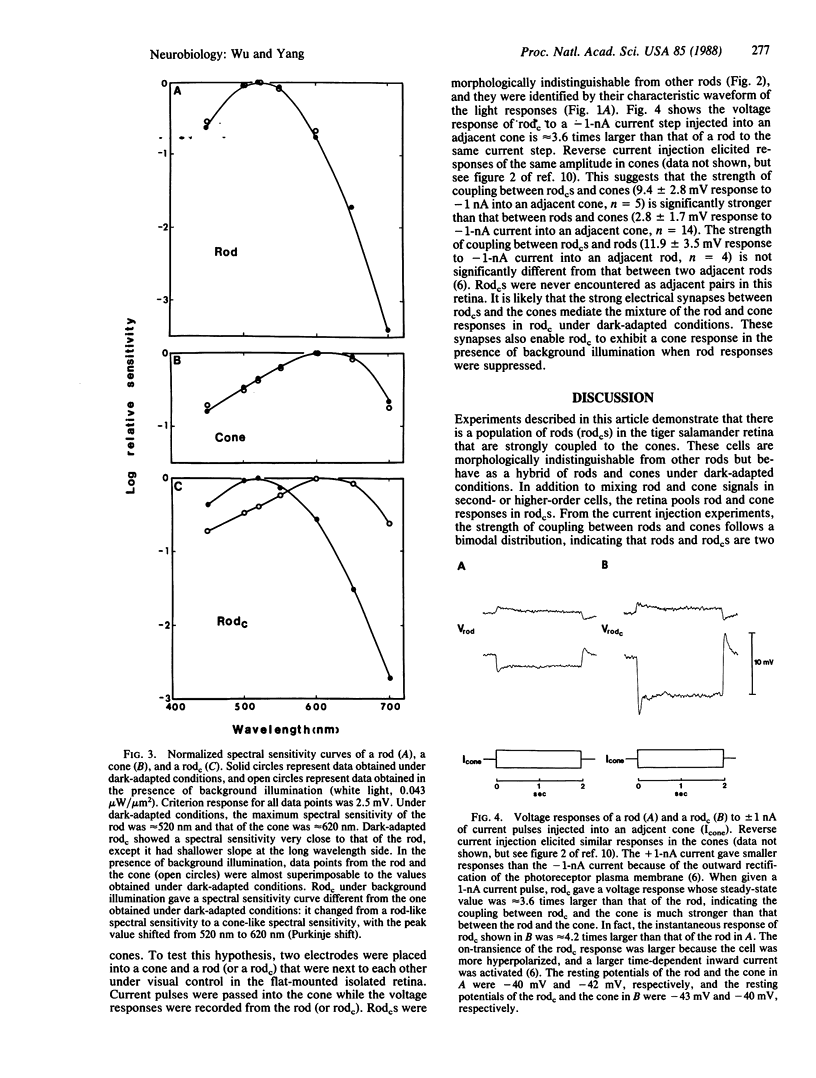Abstract
Electrical coupling between rods and cones was studied in the salamander (Ambystoma tigrinum) retina by measuring the light responses and spectral sensitivities of rods and cones and by measuring the voltage responses from a rod to current pulses injected into a cone. A population of 10-20% of the photoreceptors exhibited a mixed-response waveform of the rod and the cone under dark-adapted conditions, and a response waveform closely resembled that of a cone in the presence of background illumination. Lucifer yellow injection revealed that these cells are morphologically identical to rods, and thus they are named rodcs. Dark-adapted rodcs exhibited a rod-like spectral sensitivity with a peak at approximately 520 nm that shifted to a cone-like spectral sensitivity with a peak at approximately 620 nm in response to background light (Purkinje shift). The voltage response of a rodc to a -1-nA current step injected into an adjacent cone is approximately 3.6 times larger than that of a rod to the same current step. These results indicate that there is a population of rods (rodcs) in the tiger salamander retina that is strongly coupled to the cones and that these cells allow significant mixture of rod and cone signals at the photoreceptor level.
Full text
PDF



Images in this article
Selected References
These references are in PubMed. This may not be the complete list of references from this article.
- Attwell D., Werblin F. S., Wilson M., Wu S. M. A sign-reversing pathway from rods to double and single cones in the retina of the tiger salamander. J Physiol. 1983 Mar;336:313–333. doi: 10.1113/jphysiol.1983.sp014583. [DOI] [PMC free article] [PubMed] [Google Scholar]
- Attwell D., Wilson M. Behaviour of the rod network in the tiger salamander retina mediated by membrane properties of individual rods. J Physiol. 1980 Dec;309:287–315. doi: 10.1113/jphysiol.1980.sp013509. [DOI] [PMC free article] [PubMed] [Google Scholar]
- Attwell D., Wilson M., Wu S. M. A quantitative analysis of interactions between photoreceptors in the salamander (Ambystoma) retina. J Physiol. 1984 Jul;352:703–737. doi: 10.1113/jphysiol.1984.sp015318. [DOI] [PMC free article] [PubMed] [Google Scholar]
- Baylor D. A., Fuortes M. G., O'Bryan P. M. Receptive fields of cones in the retina of the turtle. J Physiol. 1971 Apr;214(2):265–294. doi: 10.1113/jphysiol.1971.sp009432. [DOI] [PMC free article] [PubMed] [Google Scholar]
- Baylor D. A., Hodgkin A. L. Detection and resolution of visual stimuli by turtle photoreceptors. J Physiol. 1973 Oct;234(1):163–198. doi: 10.1113/jphysiol.1973.sp010340. [DOI] [PMC free article] [PubMed] [Google Scholar]
- Daw N. W., Pearlman A. L. Cat colour vision: evidence for more than one cone process. J Physiol. 1970 Nov;211(1):125–137. doi: 10.1113/jphysiol.1970.sp009270. [DOI] [PMC free article] [PubMed] [Google Scholar]
- Fain G. L., Gold G. H., Dowling J. E. Receptor coupling in the toad retina. Cold Spring Harb Symp Quant Biol. 1976;40:547–561. doi: 10.1101/sqb.1976.040.01.051. [DOI] [PubMed] [Google Scholar]
- Lamb T. D., Simon E. J. The relation between intercellular coupling and electrical noise in turtle photoreceptors. J Physiol. 1976 Dec;263(2):257–286. doi: 10.1113/jphysiol.1976.sp011631. [DOI] [PMC free article] [PubMed] [Google Scholar]
- Mollon J. D. Color vision. Annu Rev Psychol. 1982;33:41–85. doi: 10.1146/annurev.ps.33.020182.000353. [DOI] [PubMed] [Google Scholar]
- RUSHTON W. A. Excitation pools in the frog's retina. J Physiol. 1959 Dec;149:327–345. doi: 10.1113/jphysiol.1959.sp006343. [DOI] [PMC free article] [PubMed] [Google Scholar]
- Schwartz E. A. Electrical properties of the rod syncytium in the retina of the turtle. J Physiol. 1976 May;257(2):379–406. doi: 10.1113/jphysiol.1976.sp011374. [DOI] [PMC free article] [PubMed] [Google Scholar]
- Werblin F. S. Transmission along and between rods in the tiger salamander retina. J Physiol. 1978 Jul;280:449–470. doi: 10.1113/jphysiol.1978.sp012394. [DOI] [PMC free article] [PubMed] [Google Scholar]
- Wu S. M. Changes in response waveform of retinal horizontal cells during dark and light adaptation. Vision Res. 1987;27(2):143–150. doi: 10.1016/0042-6989(87)90177-5. [DOI] [PubMed] [Google Scholar]



